Diterpenoids from Rosmarinus officinalis L. and their nitric oxide inhibitory activity
One icetexane diterpenoid, demethylsalvicanol (1) and four abietane diterpenoids, sageone (2), 20-deoxocarnosol
(3), 11,12,20-trihydroxy-abieta-8,11,13-triene (4), and 7α-ethoxyrosmanol (5) were isolated from the n-hexane layer of
the leaves and twigs of Rosmarinus officinalis L. Chemical structures of compounds were identified by ESI-MS, 1D-,
2D-NMR spectra and by comparison of the spectral data in the literature. Compounds 1-5 were evaluated antiinflammatory activity by inhibitory NO production, LPS stimulated on RAW 264.7 cells. At a concentration of 100 µM,
compound 4 exhibited inhibitory percentage of 34.7±1.8 %, meanwhile compounds 1-3 and 5 showed cytotoxic effect.
After dilution to concentration of 20 µM, except compound 1 and 2, compounds 3-5 did not show cytotoxic effect.
Their NO inhibitory productions were ranging from 20.5±2.4 % to 26.7±1.9 %. Compounds 1, 3 and 4 have been
reported for the first time from the Rosmarinus genus.
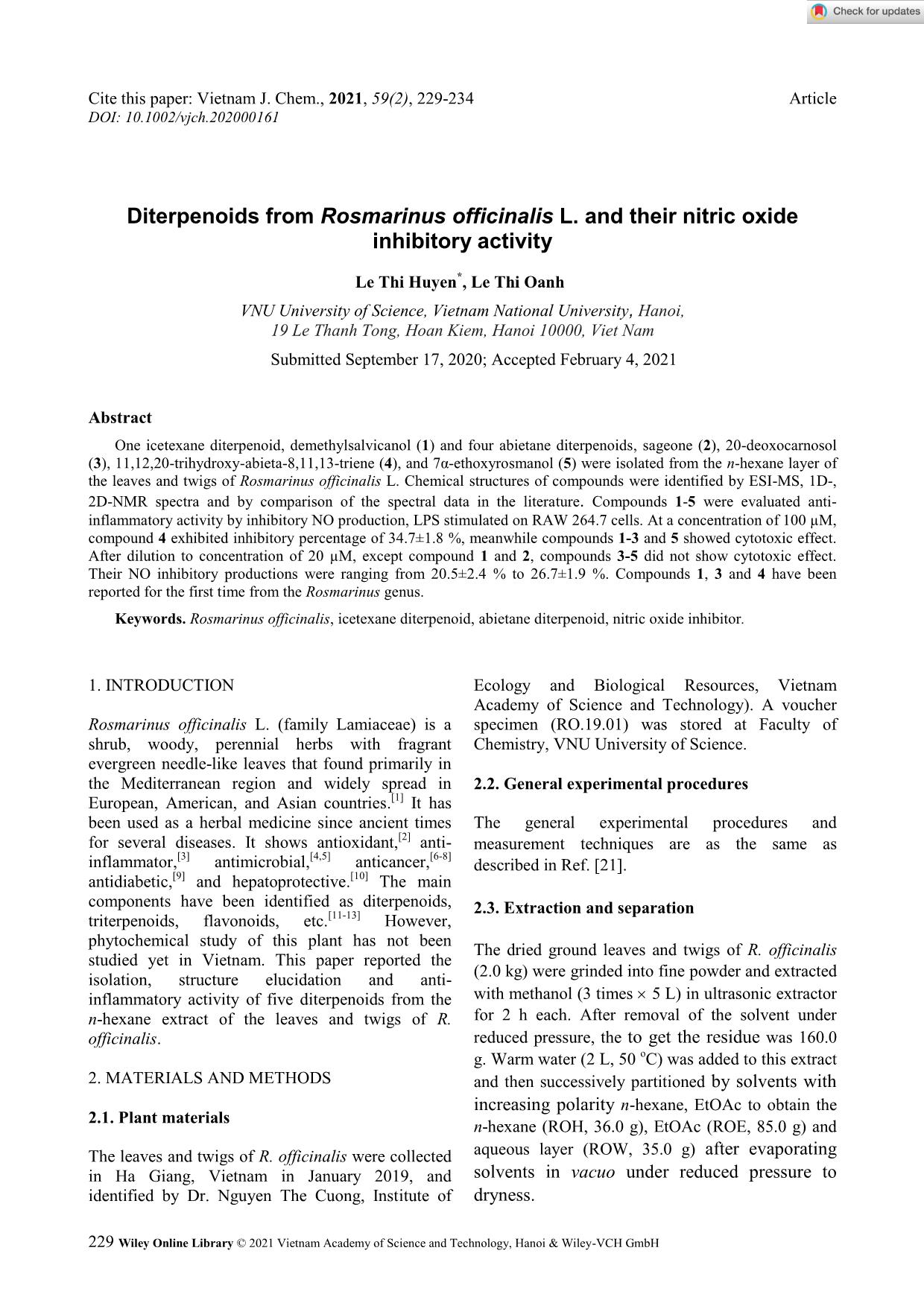
Trang 1
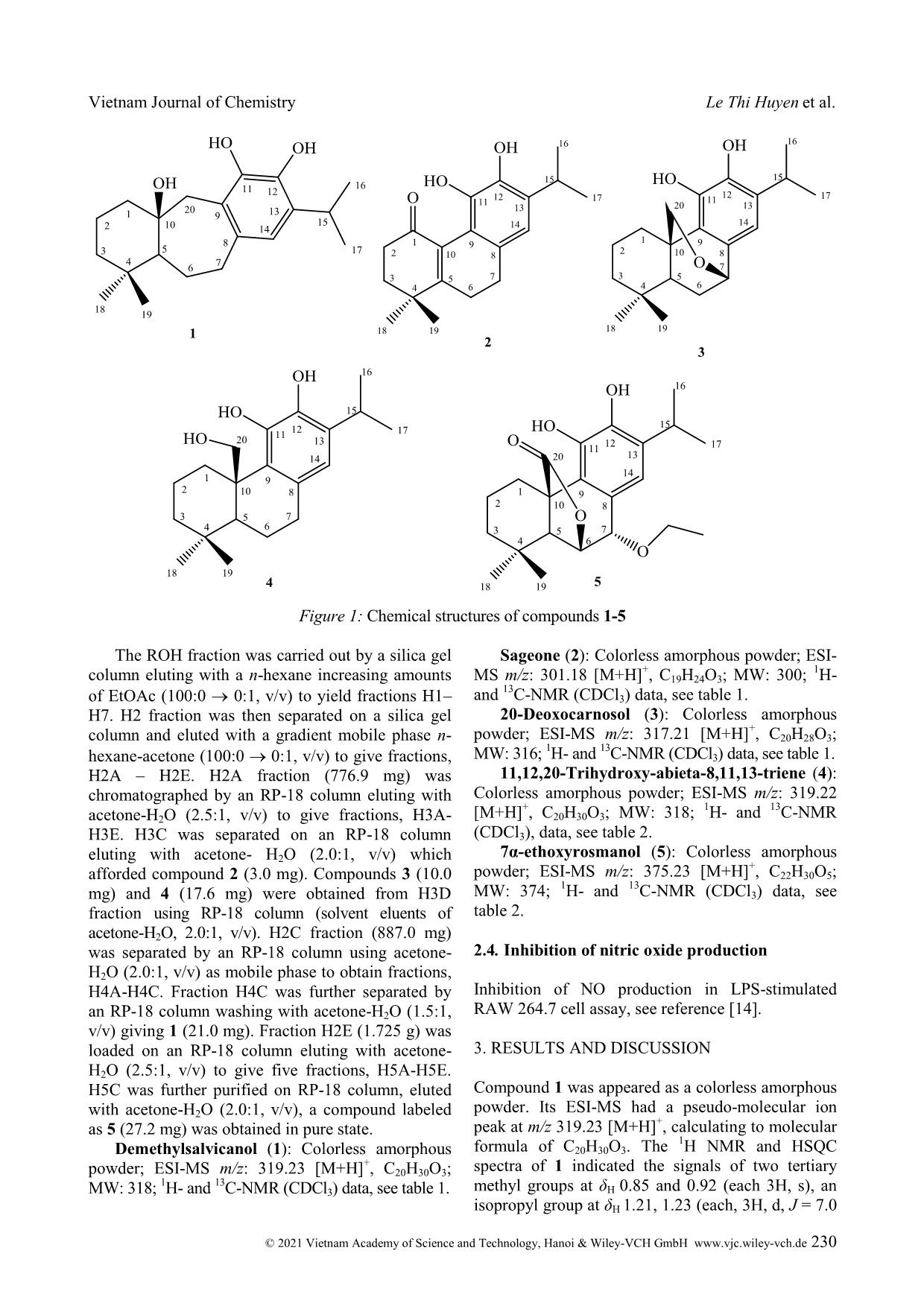
Trang 2
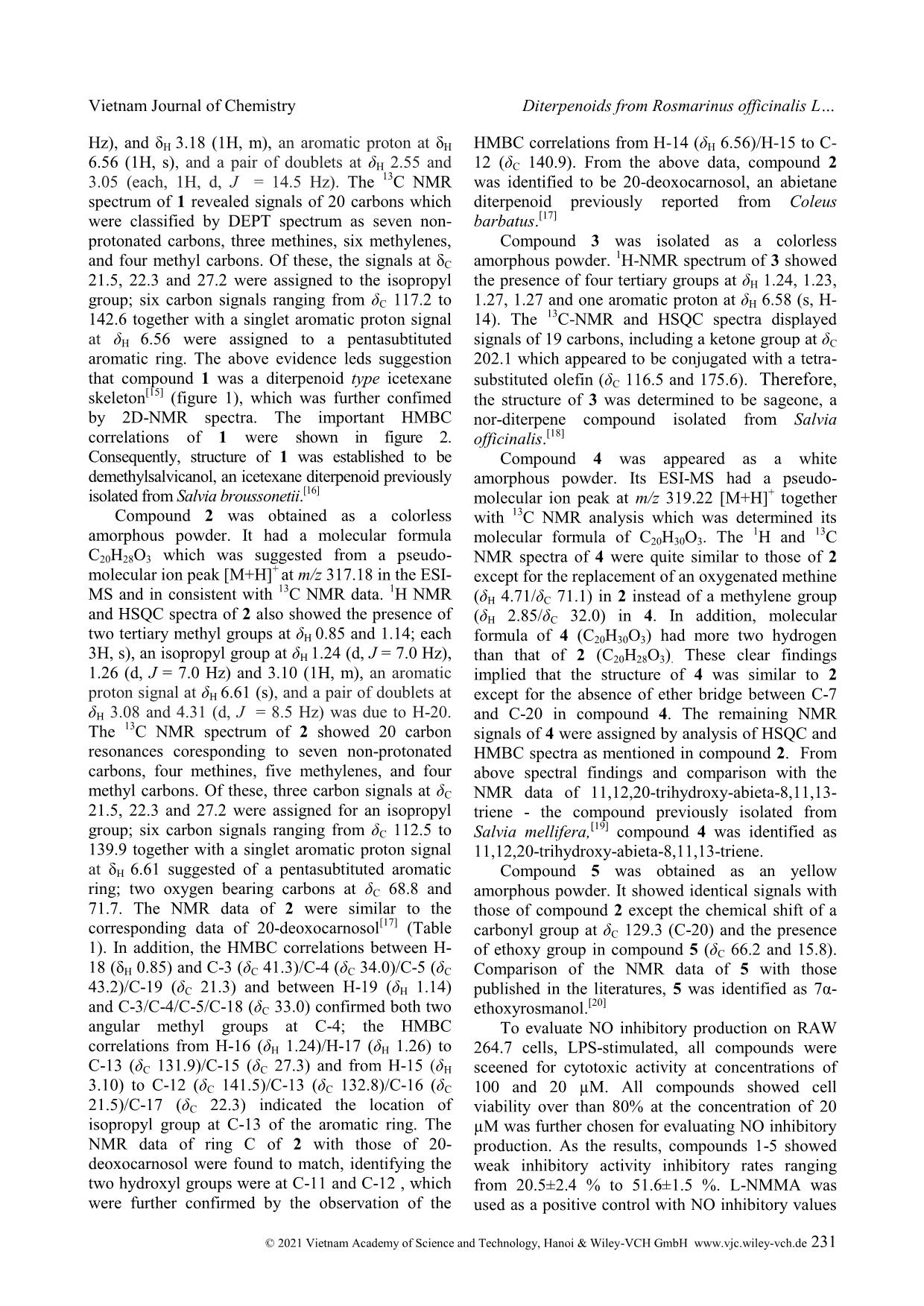
Trang 3
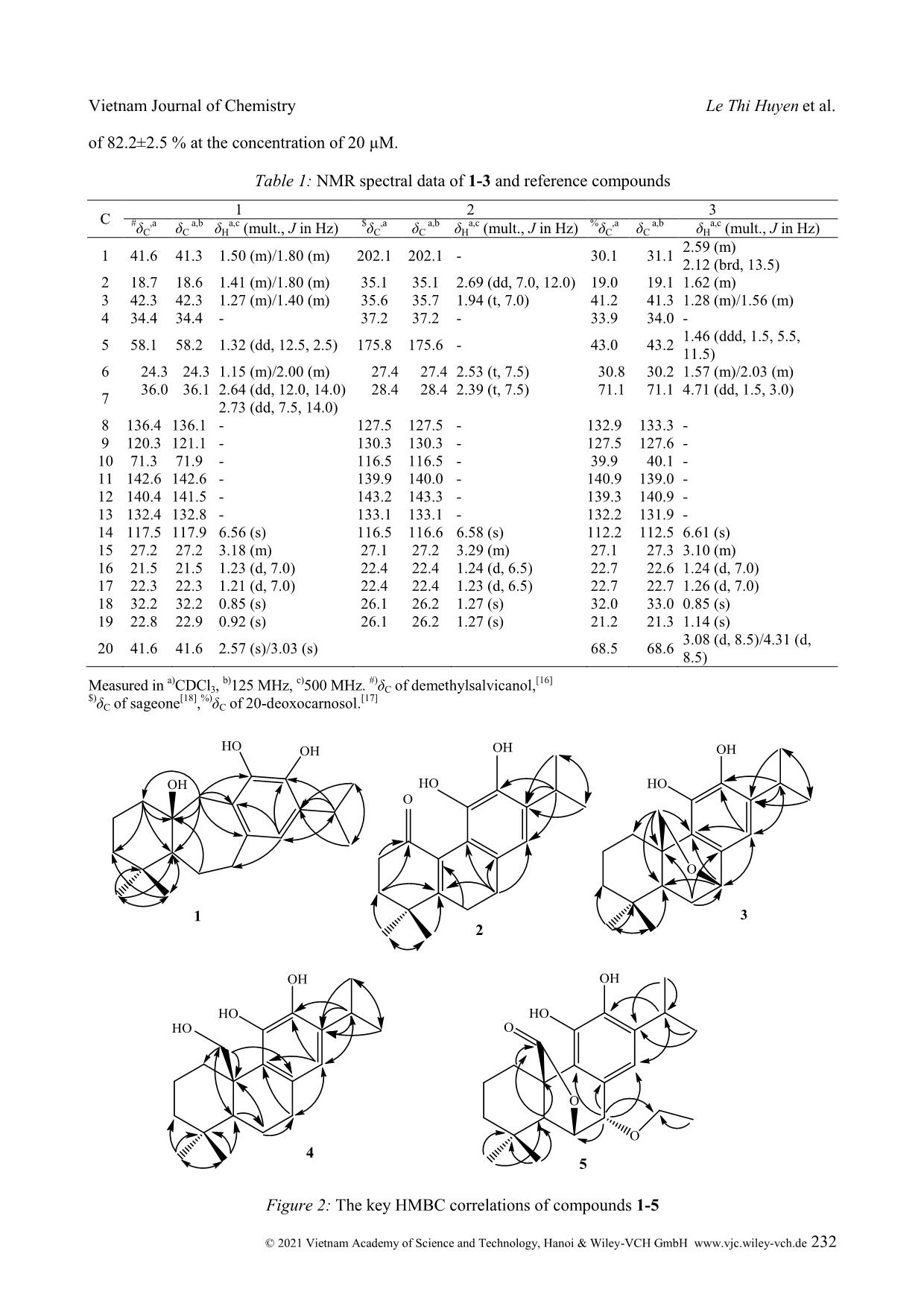
Trang 4
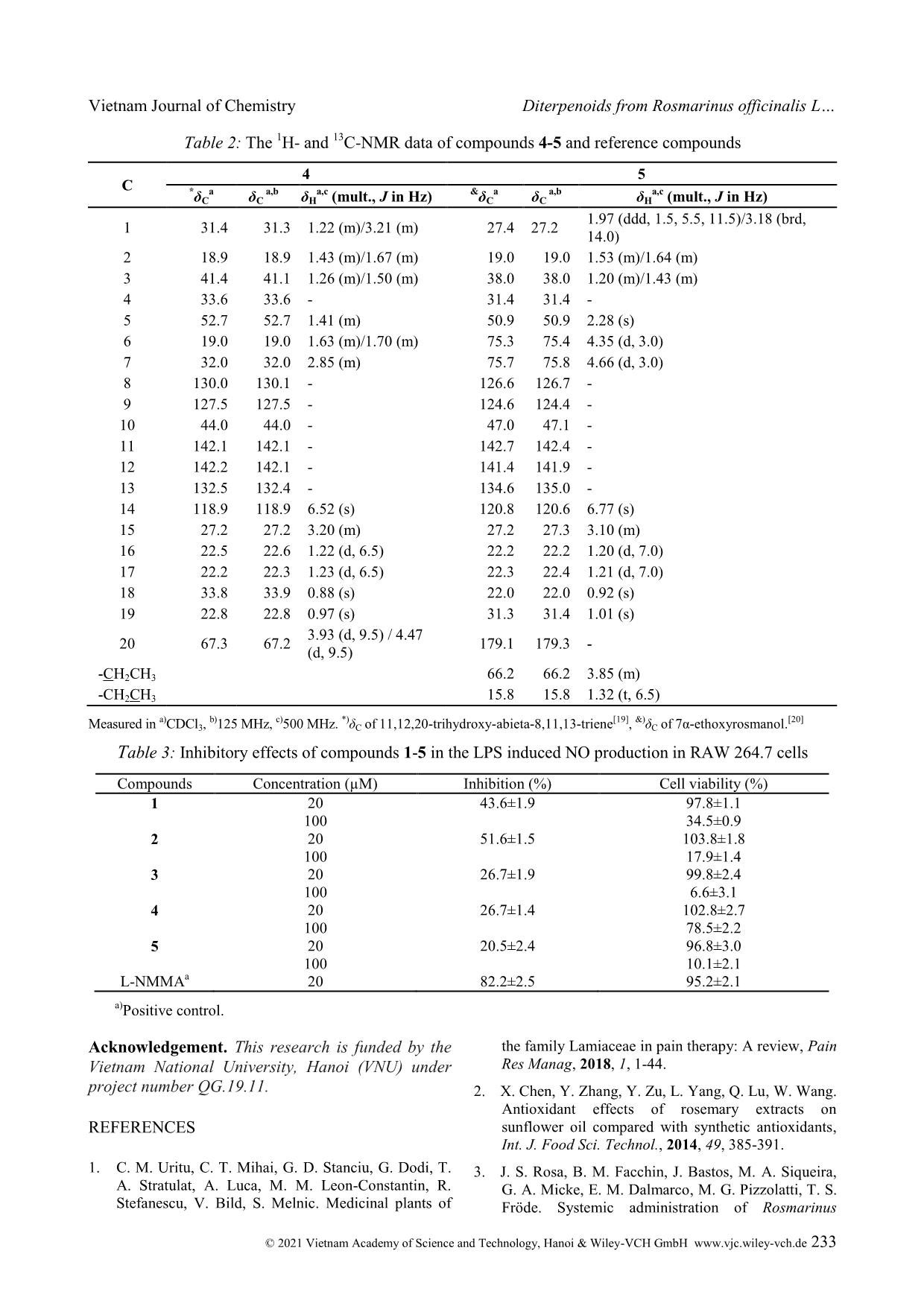
Trang 5
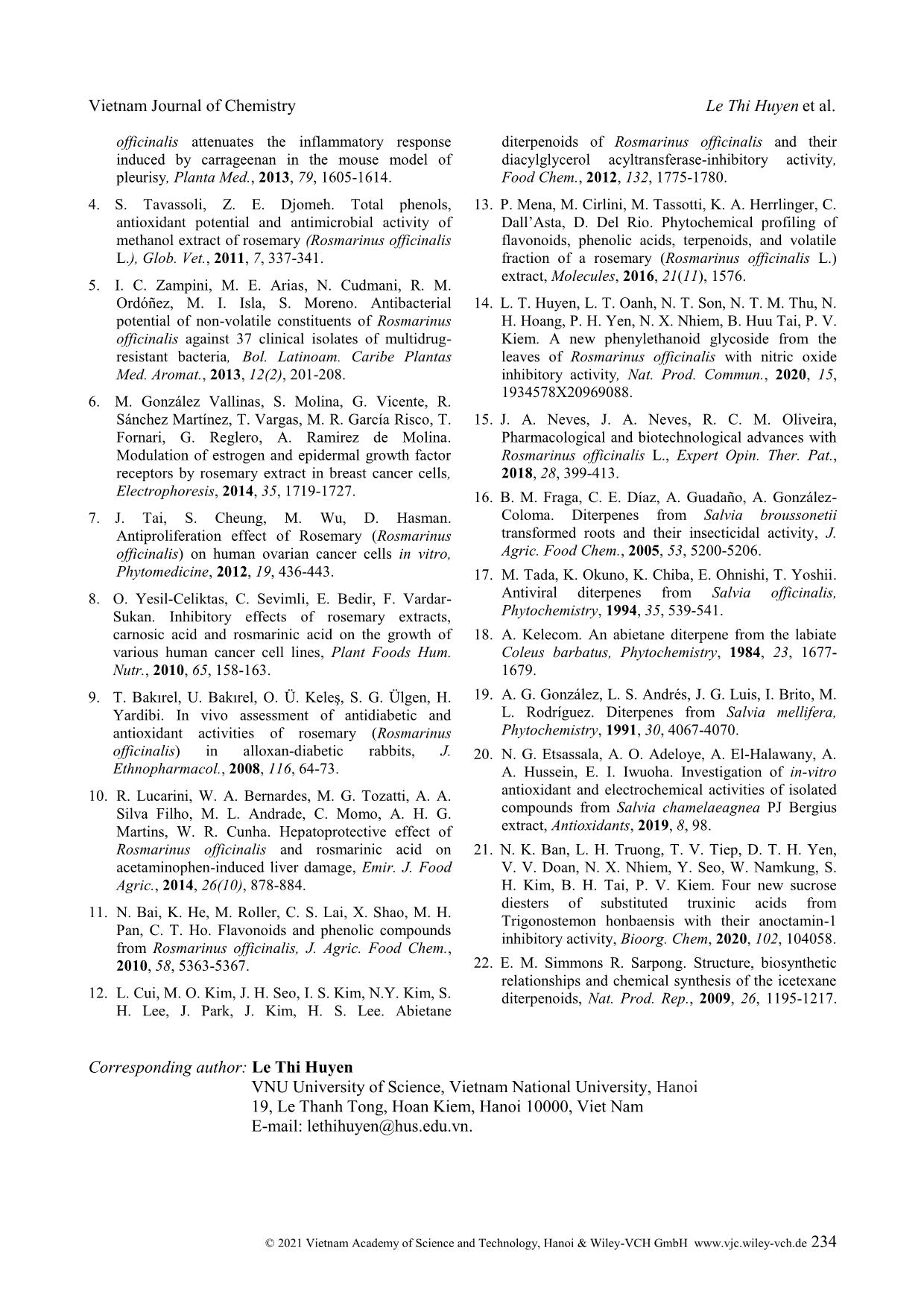
Trang 6
Tóm tắt nội dung tài liệu: Diterpenoids from Rosmarinus officinalis L. and their nitric oxide inhibitory activity
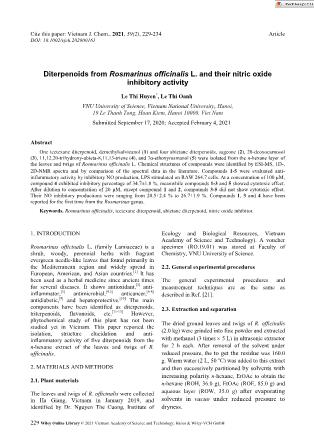
Cite this paper: Vietnam J. Chem., 2021, 59(2), 229-234 Article DOI: 10.1002/vjch.202000161 229 Wiley Online Library © 2021 Vietnam Academy of Science and Technology, Hanoi & Wiley-VCH GmbH Diterpenoids from Rosmarinus officinalis L. and their nitric oxide inhibitory activity Le Thi Huyen * , Le Thi Oanh VNU University of Science, Vietnam National University, Hanoi, 19 Le Thanh Tong, Hoan Kiem, Hanoi 10000, Viet Nam Submitted September 17, 2020; Accepted February 4, 2021 Abstract One icetexane diterpenoid, demethylsalvicanol (1) and four abietane diterpenoids, sageone (2), 20-deoxocarnosol (3), 11,12,20-trihydroxy-abieta-8,11,13-triene (4), and 7α-ethoxyrosmanol (5) were isolated from the n-hexane layer of the leaves and twigs of Rosmarinus officinalis L. Chemical structures of compounds were identified by ESI-MS, 1D-, 2D-NMR spectra and by comparison of the spectral data in the literature. Compounds 1-5 were evaluated anti- inflammatory activity by inhibitory NO production, LPS stimulated on RAW 264.7 cells. At a concentration of 100 µM, compound 4 exhibited inhibitory percentage of 34.7±1.8 %, meanwhile compounds 1-3 and 5 showed cytotoxic effect. After dilution to concentration of 20 µM, except compound 1 and 2, compounds 3-5 did not show cytotoxic effect. Their NO inhibitory productions were ranging from 20.5±2.4 % to 26.7±1.9 %. Compounds 1, 3 and 4 have been reported for the first time from the Rosmarinus genus. Keywords. Rosmarinus officinalis, icetexane diterpenoid, abietane diterpenoid, nitric oxide inhibitor. 1. INTRODUCTION Rosmarinus officinalis L. (family Lamiaceae) is a shrub, woody, perennial herbs with fragrant evergreen needle-like leaves that found primarily in the Mediterranean region and widely spread in European, American, and Asian countries. [1] It has been used as a herbal medicine since ancient times for several diseases. It shows antioxidant, [2] anti- inflammator, [3] antimicrobial, [4,5] anticancer, [6-8] antidiabetic, [9] and hepatoprotective. [10] The main components have been identified as diterpenoids, triterpenoids, flavonoids, etc. [11-13] However, phytochemical study of this plant has not been studied yet in Vietnam. This paper reported the isolation, structure elucidation and anti- inflammatory activity of five diterpenoids from the n-hexane extract of the leaves and twigs of R. officinalis. 2. MATERIALS AND METHODS 2.1. Plant materials The leaves and twigs of R. officinalis were collected in Ha Giang, Vietnam in January 2019, and identified by Dr. Nguyen The Cuong, Institute of Ecology and Biological Resources, Vietnam Academy of Science and Technology). A voucher specimen (RO.19.01) was stored at Faculty of Chemistry, VNU University of Science. 2.2. General experimental procedures The general experimental procedures and measurement techniques are as the same as described in Ref. [21]. 2.3. Extraction and separation The dried ground leaves and twigs of R. officinalis (2.0 kg) were grinded into fine powder and extracted with methanol (3 times 5 L) in ultrasonic extractor for 2 h each. After removal of the solvent under reduced pressure, the to get the residue was 160.0 g. Warm water (2 L, 50 o C) was added to this extract and then successively partitioned by solvents with increasing polarity n-hexane, EtOAc to obtain the n-hexane (ROH, 36.0 g), EtOAc (ROE, 85.0 g) and aqueous layer (ROW, 35.0 g) after evaporating solvents in vacuo under reduced pressure to dryness. Vietnam Journal of Chemistry Le Thi Huyen et al. © 2021 Vietnam Academy of Science and Technology, Hanoi & Wiley-VCH GmbH www.vjc.wiley-vch.de 230 Figure 1: Chemical structures of compounds 1-5 The ROH fraction was carried out by a silica gel column eluting with a n-hexane increasing amounts of EtOAc (100:0 0:1, v/v) to yield fractions H1– H7. H2 fraction was then separated on a silica gel column and eluted with a gradient mobile phase n- hexane-acetone (100:0 0:1, v/v) to give fractions, H2A – H2E. H2A fraction (776.9 mg) was chromatographed by an RP-18 column eluting with acetone-H2O (2.5:1, v/v) to give fractions, H3A- H3E. H3C was separated on an RP-18 column eluting with acetone- H2O (2.0:1, v/v) which afforded compound 2 (3.0 mg). Compounds 3 (10.0 mg) and 4 (17.6 mg) were obtained from H3D fraction using RP-18 column (solvent eluents of acetone-H2O, 2.0:1, v/v). H2C fraction (887.0 mg) was separated by an RP-18 column using acetone- H2O (2.0:1, v/v) as mobile phase to obtain fractions, H4A-H4C. Fraction H4C was further separated by an RP-18 column washing with acetone-H2O (1.5:1, v/v) giving 1 (21.0 mg). Fraction H2E (1.725 g) was loaded on an RP-18 column eluting with acetone- H2O (2.5:1, v/v) to give five fractions, H5A-H5E. H5C was further purified on RP-18 column, eluted with acetone-H2O (2.0:1, v/v), a compound labeled as 5 (27.2 mg) was obtained in pure state. Demethylsalvicanol (1): Colorless amorphous powder; ESI-MS m/z: 319.23 [M+H] + , C20H30O3; MW: 318; 1 H- and 13 C-NMR (CDCl3) data, see table 1. Sageone (2): Colorless amorphous powder; ESI- MS m/z: 301.18 [M+H] + , C19H24O3; MW: 300; 1 H- and 13 C-NMR (CDCl3) data, see table 1. 20-Deoxocarnosol (3): Colorless amorphous powder; ESI-MS m/z: 317.21 [M+H] + , C20H28O3; MW: 316; 1 H- and 13 C-NMR (CDCl3) data, see table 1. 11,12,20-Trihydroxy-abieta-8,11,13-triene (4): Colorless amorphous powder; ESI-MS m/z: 319.22 [M+H] + , C20H30O3; MW: 318; 1 H- and 13 C-NMR (CDCl3), data, see table 2. 7α-ethoxyrosmanol (5): Colorless amorphous powder; ESI-MS m/z: 375.23 [M+H] + , C22H30O5; MW: 374; 1 H- and 13 C-NMR (CDCl3) data, see table 2. 2.4. Inhibition of nitric oxide production Inhibition of NO production in LPS-stimulated RAW 264.7 cell assay, see reference ... lished to be demethylsalvicanol, an icetexane diterpenoid previously isolated from Salvia broussonetii. [16] Compound 2 was obtained as a colorless amorphous powder. It had a molecular formula C20H28O3 which was suggested from a pseudo- molecular ion peak [M+H] + at m/z 317.18 in the ESI- MS and in consistent with 13 C NMR data. 1 H NMR and HSQC spectra of 2 also showed the presence of two tertiary methyl groups at δH 0.85 and 1.14; each 3H, s), an isopropyl group at δH 1.24 (d, J = 7.0 Hz), 1.26 (d, J = 7.0 Hz) and 3.10 (1H, m), an aromatic proton signal at δH 6.61 (s), and a pair of doublets at δH 3.08 and 4.31 (d, J = 8.5 Hz) was due to H-20. The 13 C NMR spectrum of 2 showed 20 carbon resonances coresponding to seven non-protonated carbons, four methines, five methylenes, and four methyl carbons. Of these, three carbon signals at δC 21.5, 22.3 and 27.2 were assigned for an isopropyl group; six carbon signals ranging from δC 112.5 to 139.9 together with a singlet aromatic proton signal at δH 6.61 suggested of a pentasubtituted aromatic ring; two oxygen bearing carbons at δC 68.8 and 71.7. The NMR data of 2 were similar to the corresponding data of 20-deoxocarnosol [17] (Table 1). In addition, the HMBC correlations between H- 18 (δH 0.85) and C-3 (δC 41.3)/C-4 (δC 34.0)/C-5 (δC 43.2)/C-19 (δC 21.3) and between H-19 (δH 1.14) and C-3/C-4/C-5/C-18 (δC 33.0) confirmed both two angular methyl groups at C-4; the HMBC correlations from H-16 (δH 1.24)/H-17 (δH 1.26) to C-13 (δC 131.9)/C-15 (δC 27.3) and from H-15 (δH 3.10) to C-12 (δC 141.5)/C-13 (δC 132.8)/C-16 (δC 21.5)/C-17 (δC 22.3) indicated the location of isopropyl group at C-13 of the aromatic ring. The NMR data of ring C of 2 with those of 20- deoxocarnosol were found to match, identifying the two hydroxyl groups were at C-11 and C-12 , which were further confirmed by the observation of the HMBC correlations from H-14 (δH 6.56)/H-15 to C- 12 (δC 140.9). From the above data, compound 2 was identified to be 20-deoxocarnosol, an abietane diterpenoid previously reported from Coleus barbatus. [17] Compound 3 was isolated as a colorless amorphous powder. 1 H-NMR spectrum of 3 showed the presence of four tertiary groups at δH 1.24, 1.23, 1.27, 1.27 and one aromatic proton at δH 6.58 (s, H- 14). The 13 C-NMR and HSQC spectra displayed signals of 19 carbons, including a ketone group at δC 202.1 which appeared to be conjugated with a tetra- substituted olefin (δC 116.5 and 175.6). Therefore, the structure of 3 was determined to be sageone, a nor-diterpene compound isolated from Salvia officinalis. [18] Compound 4 was appeared as a white amorphous powder. Its ESI-MS had a pseudo- molecular ion peak at m/z 319.22 [M+H] + together with 13 C NMR analysis which was determined its molecular formula of C20H30O3. The 1 H and 13 C NMR spectra of 4 were quite similar to those of 2 except for the replacement of an oxygenated methine (δH 4.71/δC 71.1) in 2 instead of a methylene group (δH 2.85/δC 32.0) in 4. In addition, molecular formula of 4 (C20H30O3) had more two hydrogen than that of 2 (C20H28O3). These clear findings implied that the structure of 4 was similar to 2 except for the absence of ether bridge between C-7 and C-20 in compound 4. The remaining NMR signals of 4 were assigned by analysis of HSQC and HMBC spectra as mentioned in compound 2. From above spectral findings and comparison with the NMR data of 11,12,20-trihydroxy-abieta-8,11,13- triene - the compound previously isolated from Salvia mellifera, [19] compound 4 was identified as 11,12,20-trihydroxy-abieta-8,11,13-triene. Compound 5 was obtained as an yellow amorphous powder. It showed identical signals with those of compound 2 except the chemical shift of a carbonyl group at δC 129.3 (C-20) and the presence of ethoxy group in compound 5 (δC 66.2 and 15.8). Comparison of the NMR data of 5 with those published in the literatures, 5 was identified as 7α- ethoxyrosmanol. [20] To evaluate NO inhibitory production on RAW 264.7 cells, LPS-stimulated, all compounds were sceened for cytotoxic activity at concentrations of 100 and 20 µM. All compounds showed cell viability over than 80% at the concentration of 20 µM was further chosen for evaluating NO inhibitory production. As the results, compounds 1-5 showed weak inhibitory activity inhibitory rates ranging from 20.5±2.4 % to 51.6±1.5 %. L-NMMA was used as a positive control with NO inhibitory values Vietnam Journal of Chemistry Le Thi Huyen et al. © 2021 Vietnam Academy of Science and Technology, Hanoi & Wiley-VCH GmbH www.vjc.wiley-vch.de 232 of 82.2±2.5 % at the concentration of 20 µM. Table 1: NMR spectral data of 1-3 and reference compounds C 1 2 3 #δC ,a δC a,b δH a,c (mult., J in Hz) $δC ,a δC a,b δH a,c (mult., J in Hz) %δC ,a δC a,b δH a,c (mult., J in Hz) 1 41.6 41.3 1.50 (m)/1.80 (m) 202.1 202.1 - 30.1 31.1 2.59 (m) 2.12 (brd, 13.5) 2 18.7 18.6 1.41 (m)/1.80 (m) 35.1 35.1 2.69 (dd, 7.0, 12.0) 19.0 19.1 1.62 (m) 3 42.3 42.3 1.27 (m)/1.40 (m) 35.6 35.7 1.94 (t, 7.0) 41.2 41.3 1.28 (m)/1.56 (m) 4 34.4 34.4 - 37.2 37.2 - 33.9 34.0 - 5 58.1 58.2 1.32 (dd, 12.5, 2.5) 175.8 175.6 - 43.0 43.2 1.46 (ddd, 1.5, 5.5, 11.5) 6 24.3 24.3 1.15 (m)/2.00 (m) 27.4 27.4 2.53 (t, 7.5) 30.8 30.2 1.57 (m)/2.03 (m) 7 36.0 36.1 2.64 (dd, 12.0, 14.0) 2.73 (dd, 7.5, 14.0) 28.4 28.4 2.39 (t, 7.5) 71.1 71.1 4.71 (dd, 1.5, 3.0) 8 136.4 136.1 - 127.5 127.5 - 132.9 133.3 - 9 120.3 121.1 - 130.3 130.3 - 127.5 127.6 - 10 71.3 71.9 - 116.5 116.5 - 39.9 40.1 - 11 142.6 142.6 - 139.9 140.0 - 140.9 139.0 - 12 140.4 141.5 - 143.2 143.3 - 139.3 140.9 - 13 132.4 132.8 - 133.1 133.1 - 132.2 131.9 - 14 117.5 117.9 6.56 (s) 116.5 116.6 6.58 (s) 112.2 112.5 6.61 (s) 15 27.2 27.2 3.18 (m) 27.1 27.2 3.29 (m) 27.1 27.3 3.10 (m) 16 21.5 21.5 1.23 (d, 7.0) 22.4 22.4 1.24 (d, 6.5) 22.7 22.6 1.24 (d, 7.0) 17 22.3 22.3 1.21 (d, 7.0) 22.4 22.4 1.23 (d, 6.5) 22.7 22.7 1.26 (d, 7.0) 18 32.2 32.2 0.85 (s) 26.1 26.2 1.27 (s) 32.0 33.0 0.85 (s) 19 22.8 22.9 0.92 (s) 26.1 26.2 1.27 (s) 21.2 21.3 1.14 (s) 20 41.6 41.6 2.57 (s)/3.03 (s) 68.5 68.6 3.08 (d, 8.5)/4.31 (d, 8.5) Measured in a) CDCl3, b) 125 MHz, c) 500 MHz. #)δC of demethylsalvicanol, [16] $)δC of sageone [18] , %)δC of 20-deoxocarnosol. [17] Figure 2: The key HMBC correlations of compounds 1-5 Vietnam Journal of Chemistry Diterpenoids from Rosmarinus officinalis L © 2021 Vietnam Academy of Science and Technology, Hanoi & Wiley-VCH GmbH www.vjc.wiley-vch.de 233 Table 2: The 1 H- and 13 C-NMR data of compounds 4-5 and reference compounds C 4 5 *δC a δC a,b δH a,c (mult., J in Hz) &δC a δC a,b δH a,c (mult., J in Hz) 1 31.4 31.3 1.22 (m)/3.21 (m) 27.4 27.2 1.97 (ddd, 1.5, 5.5, 11.5)/3.18 (brd, 14.0) 2 18.9 18.9 1.43 (m)/1.67 (m) 19.0 19.0 1.53 (m)/1.64 (m) 3 41.4 41.1 1.26 (m)/1.50 (m) 38.0 38.0 1.20 (m)/1.43 (m) 4 33.6 33.6 - 31.4 31.4 - 5 52.7 52.7 1.41 (m) 50.9 50.9 2.28 (s) 6 19.0 19.0 1.63 (m)/1.70 (m) 75.3 75.4 4.35 (d, 3.0) 7 32.0 32.0 2.85 (m) 75.7 75.8 4.66 (d, 3.0) 8 130.0 130.1 - 126.6 126.7 - 9 127.5 127.5 - 124.6 124.4 - 10 44.0 44.0 - 47.0 47.1 - 11 142.1 142.1 - 142.7 142.4 - 12 142.2 142.1 - 141.4 141.9 - 13 132.5 132.4 - 134.6 135.0 - 14 118.9 118.9 6.52 (s) 120.8 120.6 6.77 (s) 15 27.2 27.2 3.20 (m) 27.2 27.3 3.10 (m) 16 22.5 22.6 1.22 (d, 6.5) 22.2 22.2 1.20 (d, 7.0) 17 22.2 22.3 1.23 (d, 6.5) 22.3 22.4 1.21 (d, 7.0) 18 33.8 33.9 0.88 (s) 22.0 22.0 0.92 (s) 19 22.8 22.8 0.97 (s) 31.3 31.4 1.01 (s) 20 67.3 67.2 3.93 (d, 9.5) / 4.47 (d, 9.5) 179.1 179.3 - -CH2CH3 66.2 66.2 3.85 (m) -CH2CH3 15.8 15.8 1.32 (t, 6.5) Measured in a)CDCl3, b)125 MHz, c)500 MHz. *)δC of 11,12,20-trihydroxy-abieta-8,11,13-triene [19], &)δC of 7α-ethoxyrosmanol. [20] Table 3: Inhibitory effects of compounds 1-5 in the LPS induced NO production in RAW 264.7 cells Compounds Concentration (µM) Inhibition (%) Cell viability (%) 1 20 43.6±1.9 97.8±1.1 100 34.5±0.9 2 20 51.6±1.5 103.8±1.8 100 17.9±1.4 3 20 26.7±1.9 99.8±2.4 100 6.6±3.1 4 20 26.7±1.4 102.8±2.7 100 78.5±2.2 5 20 20.5±2.4 96.8±3.0 100 10.1±2.1 L-NMMA a 20 82.2±2.5 95.2±2.1 a) Positive control. Acknowledgement. This research is funded by the Vietnam National University, Hanoi (VNU) under project number QG.19.11. REFERENCES 1. C. M. Uritu, C. T. Mihai, G. D. Stanciu, G. Dodi, T. A. Stratulat, A. Luca, M. M. Leon-Constantin, R. Stefanescu, V. Bild, S. Melnic. Medicinal plants of the family Lamiaceae in pain therapy: A review, Pain Res Manag, 2018, 1, 1-44. 2. X. Chen, Y. Zhang, Y. Zu, L. Yang, Q. Lu, W. Wang. Antioxidant effects of rosemary extracts on sunflower oil compared with synthetic antioxidants, Int. J. Food Sci. Technol., 2014, 49, 385-391. 3. J. S. Rosa, B. M. Facchin, J. Bastos, M. A. Siqueira, G. A. Micke, E. M. Dalmarco, M. G. Pizzolatti, T. S. Fröde. Systemic administration of Rosmarinus Vietnam Journal of Chemistry Le Thi Huyen et al. © 2021 Vietnam Academy of Science and Technology, Hanoi & Wiley-VCH GmbH www.vjc.wiley-vch.de 234 officinalis attenuates the inflammatory response induced by carrageenan in the mouse model of pleurisy, Planta Med., 2013, 79, 1605-1614. 4. S. Tavassoli, Z. E. Djomeh. Total phenols, antioxidant potential and antimicrobial activity of methanol extract of rosemary (Rosmarinus officinalis L.), Glob. Vet., 2011, 7, 337-341. 5. I. C. Zampini, M. E. Arias, N. Cudmani, R. M. Ordóñez, M. I. Isla, S. Moreno. Antibacterial potential of non-volatile constituents of Rosmarinus officinalis against 37 clinical isolates of multidrug- resistant bacteria, Bol. Latinoam. Caribe Plantas Med. Aromat., 2013, 12(2), 201-208. 6. M. González Vallinas, S. Molina, G. Vicente, R. Sánchez Martínez, T. Vargas, M. R. García Risco, T. Fornari, G. Reglero, A. Ramirez de Molina. Modulation of estrogen and epidermal growth factor receptors by rosemary extract in breast cancer cells, Electrophoresis, 2014, 35, 1719-1727. 7. J. Tai, S. Cheung, M. Wu, D. Hasman. Antiproliferation effect of Rosemary (Rosmarinus officinalis) on human ovarian cancer cells in vitro, Phytomedicine, 2012, 19, 436-443. 8. O. Yesil-Celiktas, C. Sevimli, E. Bedir, F. Vardar- Sukan. Inhibitory effects of rosemary extracts, carnosic acid and rosmarinic acid on the growth of various human cancer cell lines, Plant Foods Hum. Nutr., 2010, 65, 158-163. 9. T. Bakırel, U. Bakırel, O. Ü. Keleş, S. G. Ülgen, H. Yardibi. In vivo assessment of antidiabetic and antioxidant activities of rosemary (Rosmarinus officinalis) in alloxan-diabetic rabbits, J. Ethnopharmacol., 2008, 116, 64-73. 10. R. Lucarini, W. A. Bernardes, M. G. Tozatti, A. A. Silva Filho, M. L. Andrade, C. Momo, A. H. G. Martins, W. R. Cunha. Hepatoprotective effect of Rosmarinus officinalis and rosmarinic acid on acetaminophen-induced liver damage, Emir. J. Food Agric., 2014, 26(10), 878-884. 11. N. Bai, K. He, M. Roller, C. S. Lai, X. Shao, M. H. Pan, C. T. Ho. Flavonoids and phenolic compounds from Rosmarinus officinalis, J. Agric. Food Chem., 2010, 58, 5363-5367. 12. L. Cui, M. O. Kim, J. H. Seo, I. S. Kim, N.Y. Kim, S. H. Lee, J. Park, J. Kim, H. S. Lee. Abietane diterpenoids of Rosmarinus officinalis and their diacylglycerol acyltransferase-inhibitory activity, Food Chem., 2012, 132, 1775-1780. 13. P. Mena, M. Cirlini, M. Tassotti, K. A. Herrlinger, C. Dall’Asta, D. Del Rio. Phytochemical profiling of flavonoids, phenolic acids, terpenoids, and volatile fraction of a rosemary (Rosmarinus officinalis L.) extract, Molecules, 2016, 21(11), 1576. 14. L. T. Huyen, L. T. Oanh, N. T. Son, N. T. M. Thu, N. H. Hoang, P. H. Yen, N. X. Nhiem, B. Huu Tai, P. V. Kiem. A new phenylethanoid glycoside from the leaves of Rosmarinus officinalis with nitric oxide inhibitory activity, Nat. Prod. Commun., 2020, 15, 1934578X20969088. 15. J. A. Neves, J. A. Neves, R. C. M. Oliveira, Pharmacological and biotechnological advances with Rosmarinus officinalis L., Expert Opin. Ther. Pat., 2018, 28, 399-413. 16. B. M. Fraga, C. E. Díaz, A. Guadaño, A. González- Coloma. Diterpenes from Salvia broussonetii transformed roots and their insecticidal activity, J. Agric. Food Chem., 2005, 53, 5200-5206. 17. M. Tada, K. Okuno, K. Chiba, E. Ohnishi, T. Yoshii. Antiviral diterpenes from Salvia officinalis, Phytochemistry, 1994, 35, 539-541. 18. A. Kelecom. An abietane diterpene from the labiate Coleus barbatus, Phytochemistry, 1984, 23, 1677- 1679. 19. A. G. González, L. S. Andrés, J. G. Luis, I. Brito, M. L. Rodríguez. Diterpenes from Salvia mellifera, Phytochemistry, 1991, 30, 4067-4070. 20. N. G. Etsassala, A. O. Adeloye, A. El-Halawany, A. A. Hussein, E. I. Iwuoha. Investigation of in-vitro antioxidant and electrochemical activities of isolated compounds from Salvia chamelaeagnea PJ Bergius extract, Antioxidants, 2019, 8, 98. 21. N. K. Ban, L. H. Truong, T. V. Tiep, D. T. H. Yen, V. V. Doan, N. X. Nhiem, Y. Seo, W. Namkung, S. H. Kim, B. H. Tai, P. V. Kiem. Four new sucrose diesters of substituted truxinic acids from Trigonostemon honbaensis with their anoctamin-1 inhibitory activity, Bioorg. Chem, 2020, 102, 104058. 22. E. M. Simmons R. Sarpong. Structure, biosynthetic relationships and chemical synthesis of the icetexane diterpenoids, Nat. Prod. Rep., 2009, 26, 1195-1217. Corresponding author: Le Thi Huyen VNU University of Science, Vietnam National University, Hanoi 19, Le Thanh Tong, Hoan Kiem, Hanoi 10000, Viet Nam E-mail: lethihuyen@hus.edu.vn.
File đính kèm:
 diterpenoids_from_rosmarinus_officinalis_l_and_their_nitric.pdf
diterpenoids_from_rosmarinus_officinalis_l_and_their_nitric.pdf

